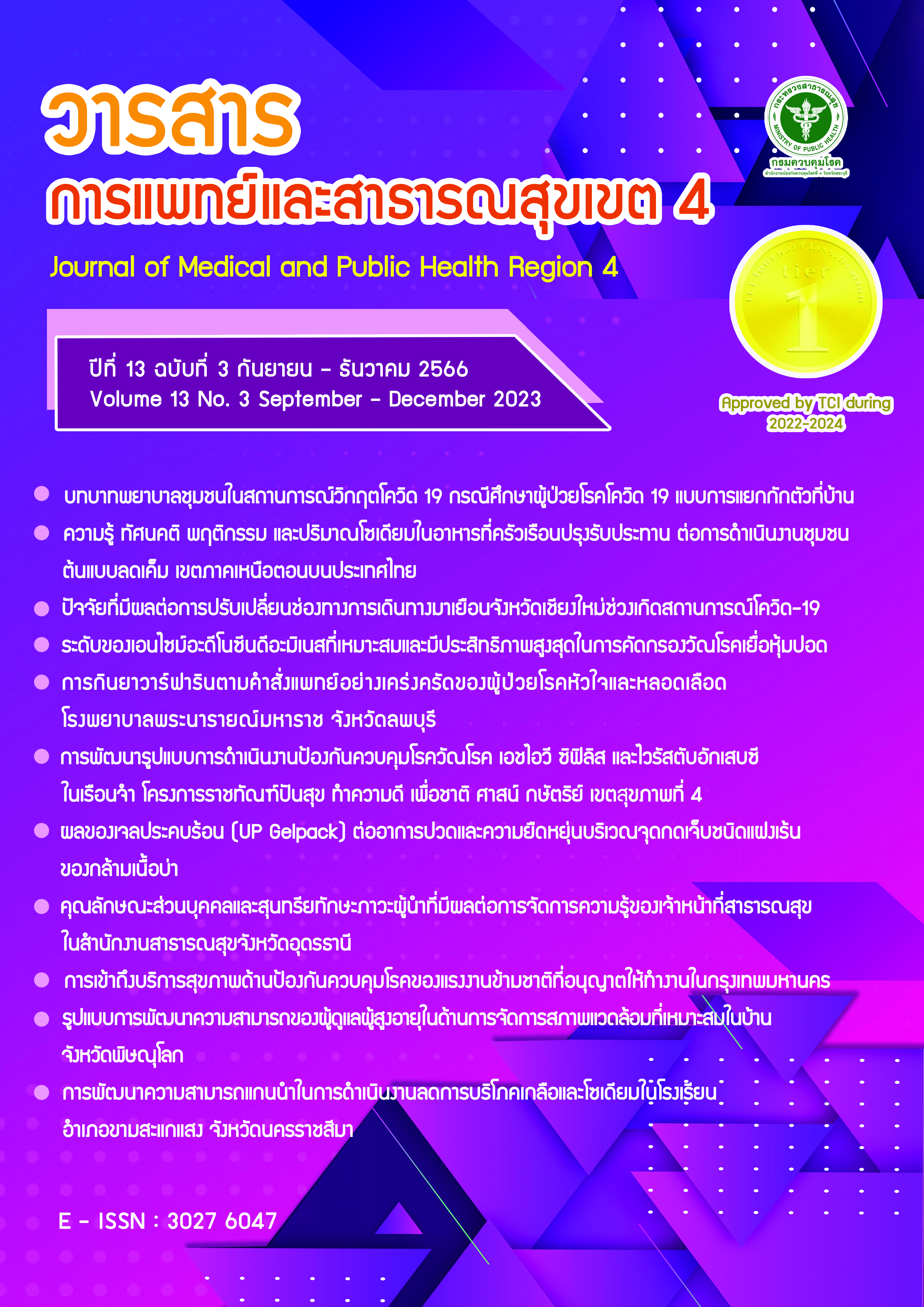Developing operational capacities of Leaders to Reduce salt and Sodium intake, school in Kham Sakaesang district, Nakhon Ratchasima province
Main Article Content
Abstract
The objectives of this research were to study of context, Problems, and enhancing the capacity of leaders to take actions in reducing salt and sodium as well as evaluate the development outcome. The method was the participatory research that used PAOR components: Planning (P), Action (A), Observation (O) and Reflection (R) at one school located in Nakhon Ratchasima Province. The study was conducted during October 2021 and February 2023.The study was focused on the two target groups: One group was comprised of 102 individuals who were actively participated in the leadership development, and another group was consisted of 309 student whose in the development outcomes which were observed within the school to assess perceptions and behavior on reduce salt and sodium intake. The data were analyzed by using the content analysis, Descriptive statistics, percentage, Mean, Standard deviation and paired t-test statistic. This study could be a development process and can be revealed that student leaders, teachers and public health officers who analyzed the school's situation, Social and environmental context, Including synthesized relevant data.The outcomes were highlighted in various school activities such as the promoting awareness and controlling, The reducing salt and sodium intake, The setting measures, The employing social media, The integrating extracurricular learning, As well as the fostering family and community connections. Resulted in indicating of the sample's perception of salt and sodium consumption which were reached a significant increase from the previous intervention (p < 0.001). Similarly, Salt and sodium consumption behaviors also were significantly higher than post-implementation (p < 0.001). These findings underscored the success of the model in affecting positive changes in food-related behaviors of the school. Guidelines should be developed for reducing salt and Sodium consumption should be developed. To present to educational institution administrators and public health service units to create participation in operations.
Article Details

This work is licensed under a Creative Commons Attribution-NonCommercial-NoDerivatives 4.0 International License.
References
World Health Organisation (WHO). Global action plan for the prevention and control of 33 noncommunicable diseases 2013-2020 [Internet]. [cited 2013 May 22]. Available from: https://www.who.int/southeastasia/publications-detail/9789241506236
Ministry of Public Health, Health Data Center system. Public health data management [Internet]. 2022 [cited 2023 March 1] Available from: https://hdcservice.moph.go.th/hdc/main/index.php (in Thai)
Aekplakorn W, Puckcharern H, Satheannoppakao W, Editor. The survey of the health of the Thai population through physical examinations, 6th round, 2019-2020 [internet]. Bangkok: Aksorn Graphic and Design; [Cited 2023 Jul 7]. Available from: https://kb.hsri.or.th/dspace/handle/11228/5425 (in Thai)
Health Assembly. Policy of Reduce salt and Sodium intake. NCD Thailand 4.0 : Moving forward [internet].2022; [Cited 2023 June 22]. Available from: https://main.samatcha.org/node/166. (in Thai)
Department of Disease Control. The Summary Report of Sodium Concentration Testing Using Chem Meter [Internet].2022. [cited 2023 Jul 7]. Avaliable from: https://ddc.moph.go.th/uploads/publish/1308920220905030102.pdf (in Thai)
Apinya T, editor. Strategies to reduce consumption of salt and sodium in Thailand, 2016-2025. Bangkok: WVO Officer of Printing Mill; 2016. Avaliable from: https://ddc.moph.go.th/uploads/publish/1308920220905030102.pdf (in Thai)
Praputnitisarn S. Participatory Action Research: Concepts and Practices Participatory action research concepts and practice. Bangkok: The Research Fund Office. 2006.
Kemmis S, Taggart RM, Nixon R. The action research planner. 3rd ed. Geelong : Deakin University Press; 1988.
Yamane, Taro.1967. Statistics, An Introductory Analysis. 2nd ed., New York : Harper and Row.
Department of Disease Control, Division of Noncommunicable Diseases. Name of the project to drive operations to monitor and reduce salt and sodium consumption at the provincial level. The Department of Disease Control. 2023. (in Thai)
Pusurinkam S. Participatory Learning: PL. Learning Community Via Network. [cited 2023 Jul 7]. Available from: https://opalnida.blogspot.com/2008/06/blog-post_13.html (in Thai)
Suwan P. Behavioral Science Health Behavior and Health Education. Bangkok: Chao Praya Publishing; 2001.
Tungvanichgapong K. Development of A Reduced Salty Intake Model in The High Blood Pressure Risk Group in Khon Kaen Province. [Internet]. Journal of Community Health Development Quarterly Khon Kaen University. 2021; 9(1): 97-109. (in Thai)
Boonsiri C, Piaseu N, Putwatana P, Kantachunesiri S. Effects of Program Promoting Food Consumption for Sodium Reduction on Knowledge and Urinary Sodium in Nursing Students. [Internet]. Journal of Nursing Council. 2017; 32(3): 104-19. (in Thai)


